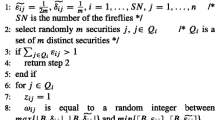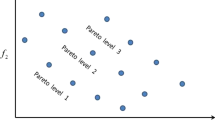Abstract
An indeterminacy economic environment includes uncertainty during adopting experts knowledge for the analysis of stock returns. The main goal in this paper is to discuss the problem of portfolio selection with uncertain environment; because, the experts alone has the ability to evaluate the security returns and not with the historical data. However, the uncertain variables considered have shown the stock returns. Uncertainty programming is used to formulate mean-variance skewness indicating the problem of portfolio selection in uncertain environment based on different decision criteria. At different conditions, some significant crisp equivalents are explained for the ease of solving models within the uncertainty theory framework. Furthermore, this paper has solved the new models included in general cases using a general method developed through designing a novel hybrid intelligent algorithm. Ultimately, the developed algorithm and models applications and performance was evidently proved using a numerical example.


Similar content being viewed by others
References
Ahmadi-Javid A (2012) Entropic value-at-risk: A new coherent risk measure. J Optim Theory Appl 155(3):1105–1123
Ahmadi-Javid A, Fallah-Tafti M (2019) Portfolio optimization with entropic value-at-risk. Eur J Oper Res 279(1):225–241
Artzner P, Delbaen F, Eber J-M, Heath D (1999) Coherent measures of risk. Math Finance 9(3):203–228
Carlsson C and Fullér R (2009) Possibilistic mean value and variance of fuzzy numbers: Some examples of application. In 2009 IEEE International Conference on Fuzzy Systems, 587–592. IEEE
Chang T-J, Yang S-C, Chang K-J (2009) Portfolio optimization problems in different risk measures using genetic algorithm. Expert Syst Appl 36(7):10529–10537
Chen K, Zhou Y, Dai F (2015) A LSTM-based method for stock returns prediction: A case study of China stock market. In 2015 IEEE international conference on big data (big data). IEEE, pp 2823–2824
Chen W, Wang Y, Gupta P, Mehlawat MK (2018) A novel hybrid heuristic algorithm for a new uncertain mean-variance-skewness portfolio selection model with real constraints. Appl Intell 48(9):2996–3018
Cheong D, Kim YM, Byun HW, Oh KJ, Kim TY (2017) Using genetic algorithm to support clustering-based portfolio optimization by investor information. Appl Soft Comput 61:593–602
Freitas FD, de Souza AF, de Almeida AR (2009) Prediction-based portfolio optimization model using neural networks. Neurocomputing 72(10–12):2155–2170
García F, González-Bueno J, Oliver J, Riley N (2019a) Selecting socially responsible portfolios: a fuzzy multicriteria approach. Sustainability 11(9):2496
García F, González-Bueno J, Oliver J, Tamošiūnienė R (2019b) A credibilistic mean-semivariance-PER portfolio selection model for Latin America. Journal of Business Economics and Management 20(2):225–243
Guijarro F and Prodromos E. Tsinaslanidis, (2019) A surrogate similarity measure for the mean-variance frontier optimisation problem under bound and cardinality constraints. Journal of the Operational Research Society, 1–16.
Gupta P, Mehlawat MK, Yadav S, Kumar A (2020) Intuitionistic fuzzy optimistic and pessimistic multi-period portfolio optimization models. Soft Comput 24(16):11931–11956
Harvey CR, Liechty JC, Liechty MW, Müller P (2010) Portfolio selection with higher moments. Quant Finance 10(5):469–485
Hsieh T-J, Hsiao H-F, Yeh W-C (2011) Forecasting stock markets using wavelet transforms and recurrent neural networks: An integrated system based on artificial bee colony algorithm. Appl Soft Comput 11(2):2510–2525
Huang X (2011) Mean-risk model for uncertain portfolio selection.". Fuzzy Optim Decis Making 10(1):71–89
Huang X, Ying H (2013) Risk index based models for portfolio adjusting problem with returns subject to experts’ evaluations. Econ Model 30:61–66
Jana P, Roy TK, Mazumder SK (2009) Multi-objective possibilistic model for portfolio selection with transaction cost. J Comput Appl Math 228(1):188–196
Li H-Q, Yi Z-H (2019) Portfolio selection with coherent Investor’s expectations under uncertainty. Expert Syst Appl 133:49–58
Li L, Li J, Qin Q, and Cheng S (2013) Credibilistic conditional value at risk under fuzzy environment. In 2013 Sixth International Conference on Advanced Computational Intelligence (ICACI), 350–353. IEEE
Li Bo, Zhu Y, Sun Y, Aw G, Teo KL (2018) Multi-period portfolio selection problem under uncertain environment with bankruptcy constraint. Appl Math Model 56:539–550
Liagkouras K, Metaxiotis K (2018) Multi-period mean–variance fuzzy portfolio optimization model with transaction costs. Eng Appl Artificial Intell 67:260–269
Lipton ZC, Berkowitz J, Elkan C (2015) A critical review of recurrent neural networks for sequence learning. arXiv preprintarXiv:1506.00019
Liu B (2010) Uncertainty theory. Springer, Berlin, pp 1–79
Liu Y, Qin Z (2012) Mean semi-absolute deviation model for uncertain portfolio optimization problem. J Uncertain Syst 6(4):299–307
Liu Y-J, Zhang W-G, Zhang Q (2016) Credibilistic multi-period portfolio optimization model with bankruptcy control and affine recourse.". Appl Soft Comput 38:890–906
Liu N, Chen Y, Liu Y (2018) Optimizing portfolio selection problems under credibilistic CVaR criterion. J Intell Fuzzy Syst 34(1):335–347
Liu YJ, Zhang WG, Gupta P (2019) Multiperiod portfolio performance evaluation model based on possibility theory. IEEE Trans Fuzzy Syst 28(12):3391–3405
Macedo LL, Godinho P, Alves MJ (2017) Mean-semivariance portfolio optimization with multi-objective evolutionary algorithms and technical analysis rules. Expert Syst Appl 79:33–43
Mehlawat MK (2016) Credibilistic mean-entropy models for multi-period portfolio selection with multi-choice aspiration levels. Inf Sci 345:9–26
Mercangöz BA, and Eroglu E (2019) The Genetic Algorithm: An Application on Portfolio Optimization. In Metaheuristic Approaches to Portfolio Optimization, 154–178 IGI Global
Mittal SK, Srivastava N (2020) Gated neural network-based mean–EVaR–skewness portfolio optimization under uncertain environment. J Circuits Syst Comput 30(6):2150100
Nelson DMQ, Pereira ACM, de Oliveira RA (2017) Stock market's price movement prediction with LSTM neural networks. In 2017 International joint conference on neural networks (IJCNN). IEEE, pp 1419–1426
Qin Z (2017) Random fuzzy mean-absolute deviation models for portfolio optimization problem with hybrid uncertainty. Applied Soft Computing 56:597–603
Qin Z, Kar S, and Li X (2009) Developments of mean-variance model for portfolio selection in uncertain environment.
Sundararaj V (2019) Optimised denoising scheme via opposition-based self-adaptive learning PSO algorithm for wavelet-based ECG signal noise reduction. Int J Biomed Eng Technol 31(4):325
Sundararaj V, Muthukumar S, Kumar RS (2018) An optimal cluster formation based energy efficient dynamic scheduling hybrid MAC protocol for heavy traffic load in wireless sensor networks. Comput Secur 77:277–288
Sundararaj V, Anoop V, Dixit P, Arjaria A, Chourasia U, Bhambri P, Rejeesh MR, Sundararaj R (2020) CCGPA-MPPT: Cauchy preferential crossover-based global pollination algorithm for MPPT in photovoltaic system. Prog Photovolt 28(11):1128–1145
Thakur M, Meghwani SS, Jalota H (2014) A modified real coded genetic algorithm for constrained optimization. Appl Math Comput 235:292–317
Vinu S (2016) An efficient threshold prediction scheme for wavelet based ECG signal noise reduction using variable step size firefly algorithm. Int J Intell Eng Syst 9(3):117–126
Vinu S (2019) Optimal task assignment in mobile cloud computing by queue based ant-bee algorithm. Wirel Pers Commun 104(1):173–197
Wang Bo, Li Y, Watada J (2017) Multi-period portfolio selection with dynamic risk/expected-return level under fuzzy random uncertainty. Inf Sci 385:1–18
Chen W, Xu W (2019) A hybrid multiobjective bat algorithm for fuzzy portfolio optimization with real-world constraints. Int J Fuzzy Syst 21(1):291–307
Yue W, Wang Y, Xuan H (2019) Fuzzy multi-objective portfolio model based on semi-variance–semi-absolute deviation risk measures. Soft Comput 23(17):8159–8179
Zhang W-G, Wang Y-L, Chen Z-P, Nie Z-K (2007) Possibilistic mean–variance models and efficient frontiers for portfolio selection problem. Inf Sci 177(13):2787–2801
Zhang W-G, Liu Y-J, Wei-Jun Xu (2012) A possibilistic mean-semivariance-entropy model for multi-period portfolio selection with transaction costs. Eur J Oper Res 222(2):341–349
Zhou J, Li X, Pedrycz W (2016) Mean-semi-entropy models of fuzzy portfolio selection. IEEE Trans Fuzzy Syst 24(6):1627–1636
Zhu H, and Zhang J (2009) A credibility-based fuzzy programming model for APP problem. In 2009 International Conference on Artificial Intelligence and Computational Intelligence, 1: 455–459 IEEE
Author information
Authors and Affiliations
Corresponding author
Additional information
Publisher's Note
Springer Nature remains neutral with regard to jurisdictional claims in published maps and institutional affiliations.
Rights and permissions
About this article
Cite this article
Mittal, S.K., Srivastava, N. Mean-variance-skewness portfolio optimization under uncertain environment using improved genetic algorithm. Artif Intell Rev 54, 6011–6032 (2021). https://doi.org/10.1007/s10462-021-09966-2
Accepted:
Published:
Issue Date:
DOI: https://doi.org/10.1007/s10462-021-09966-2




